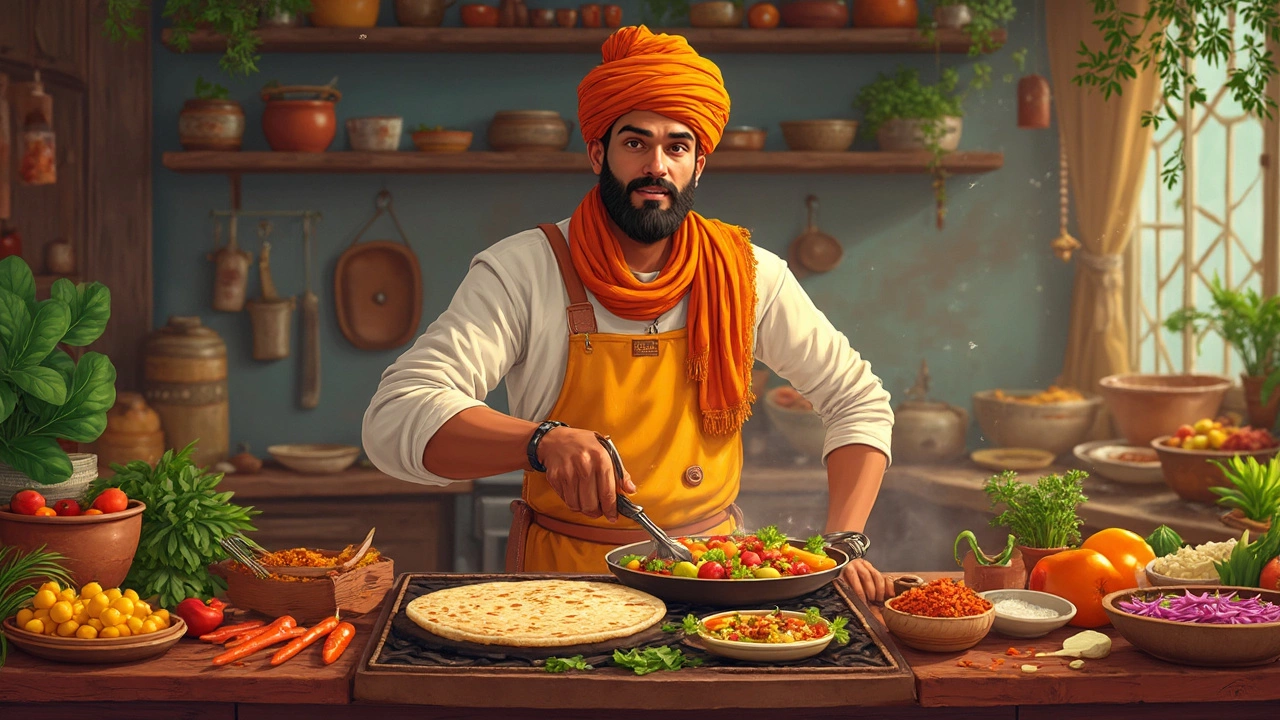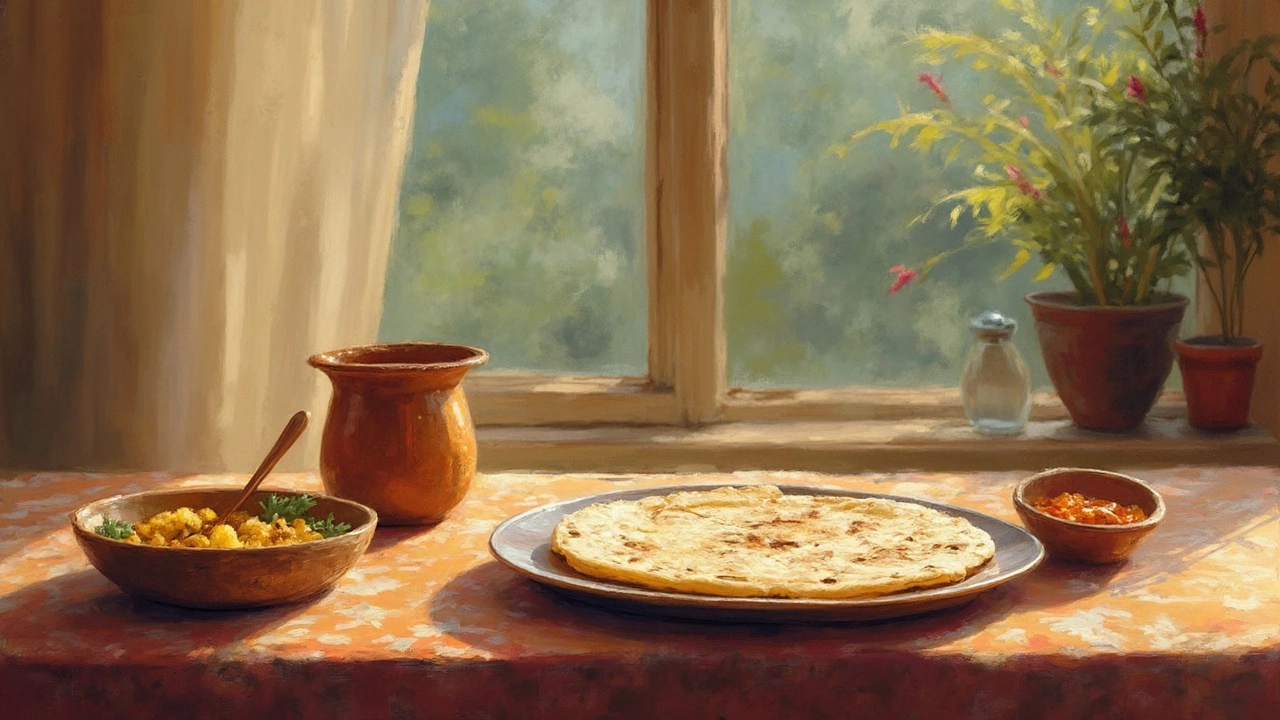Roti Calorie Guide: Essential Tips for Your Diet Planning
 Feb, 20 2025
Feb, 20 2025
When it comes to diet planning, understanding calories in everyday foods like roti can make a big difference. So, how many calories are in 1 roti? Well, on average, a plain roti contains about 70-80 calories. But the moment you start adding things, like a side of sabzi or a dash of ghee, things change a bit.
If you're pairing roti with sabzi, you're adding nutritional value. A typical serving of roti and sabzi might round up to about 200-250 calories, depending on what vegetables and oil are used. It’s better to go with a mix of colorful veggies to maximize nutrients without piling on excess calories.
Thinking of spreading some ghee on your roti? Well, that might add around 30-40 extra calories per teaspoon. While ghee is rich and delicious, it's also calorie-dense, so it’s good in moderation.
Figuring out your diet plan? Start with knowing your daily caloric needs using online calculators that consider your age, weight, and activity level. From there, you can plan meals that fit your lifestyle while being mindful of calorie intake.
- Roti and Its Caloric Content
- Roti with Sabzi: Nutritional Impact
- Adding Ghee: The Caloric Twist
- Crafting a Balanced Diet Plan
Roti and Its Caloric Content
Roti is a staple in many households and a beloved part of meals, but ever wondered what each roti adds to your calorie count? Well, knowing roti calories is crucial for effective diet planning. On average, one roti, about 6 inches in diameter, contains around 70-80 calories. But here’s a kicker: these numbers can vary based on ingredients and preparation methods.
Understanding Your Roti
Let's break it down. A basic roti is made from whole wheat flour, water, and sometimes salt. It’s cooked on an open flame or tawa. The type of flour and the size can also impact calorie content. Bigger rotis obviously have more calories, so portion control is key here.
Why Caloric Content Matters
Calorie awareness helps maintain a healthy weight. Overeating even small items can add up, and that’s where how much calories in 1 roti becomes important. To keep your diet balanced:
- Aim for consistency in roti size.
- Opt for whole grain flour for maximum nutrition.
- Be mindful of any additions like oil or butter during preparation.
Sizing Things Up
To illustrate different calorie contributions of roti, here's a small table showcasing common types:
| Type of Roti | Calories (per 6-inch Roti) |
|---|---|
| Plain Roti | 70-80 |
| Butter Roti | 100-110 |
| Stuffed Roti (Aloo/Paneer) | 150-200 |
With these insights, adjusting your meal plans becomes easier and more effective. Interested in more nutritional insights? Keep reading to learn how variations like calories in 1 roti with ghee and with different sides affect your overall intake.
Roti with Sabzi: Nutritional Impact
Combining roti with sabzi is a classic staple in many households, but what exactly does that mean for your nutrition? Simply put, it's about how you can harness the power of everyday foods to boost dietary value without adding unnecessary calories.
Roti calories come from complex carbohydrates, which provide slow-releasing energy, making them a great choice if you're aiming for sustained energy levels throughout the day. Pairing roti with a variety of vegetables not only enhances flavor but elevates nutritional content by incorporating essential vitamins, fiber, and antioxidants.
Benefits of Including Sabzi
Sabzi, typically prepared with vegetables like spinach, bell peppers, or carrots, can significantly add to your meal's nutrient profile. They offer essential vitamins like A and C, dietary fiber, and minerals which can be therapeutic for maintaining optimal health.
- Boosts Immunity: Vegetables high in vitamin C, like broccoli or bell peppers, can help enhance your immune response.
- Improves Digestion: The fiber in veggies aids in digestion, keeping your gut health in check.
- Rich in Antioxidants: Many popular sabzis are high in antioxidants, which help combat inflammation and protect cells from damage.
Crafting a Balanced Meal
When constructing a balanced meal with roti and sabzi, consider using less oil and salt. Here's a quick guide to keep it healthy and flavorful:
- Choose a Variety of Veggies: Aim for different colors to ensure a broad spectrum of nutrients.
- Mind the Oil: It's easy to go overboard with oil. Stick to just a teaspoon of olive or coconut oil, which can suffice for sautéing.
- Season Wisely: Use herbs and spices like cumin, turmeric, and coriander to add flavor without extra sodium.
One last thing to remember—a typical roti with sabzi meal contains approximately 200-250 calories, depending on the ingredients and preparation method. So, you can enjoy your meal feeling good about fueling your body right!

Adding Ghee: The Caloric Twist
Adding ghee to your roti is a popular choice for many. It adds a creamy richness and can make a meal feel extra special. However, ghee is calorie-dense, with about 112 calories per tablespoon. If you're watching your calorie count, a modest amount is key.
What’s the impact of ghee on your roti in terms of nutrition? Ghee is high in fats, which are necessary for energy, and it contains fat-soluble vitamins like A, D, E, and K. According to nutritionist Rujuta Diwekar, "Ghee is essential for the assimilation of these vitamins, which many people overlook in low-fat diets."
"Ghee supports digestion and is great for immunity," says Dr. Sandhya Taksali, a well-known Ayurvedic practitioner.
How to Add Ghee Wisely
Want to enjoy ghee without tipping the calorie scale? Here’s a simple guide to make the most of it:
- Use a small spoon to drizzle ghee over your roti. One teaspoon is generally enough to add flavor without overdoing the calories.
- If you're cooking with ghee, limit other fat sources in your meal to maintain balance.
- Include some physical activity in your routine to utilize the energy provided by those extra calories.
Weighing the Benefits
It's not all about the calories! Ghee is loaded with important short-chain fatty acids, which can boost heart health when consumed in moderation. If you're looking to increase satiety, adding a teaspoon of ghee is a great way to stay fuller longer.
For those concerned about calories, take a balanced approach. Opt for whole wheat rotis instead of refined flour, and fill up on proteins and fiber-rich vegetables. This can help create a satisfying meal that doesn’t go calorie-crazy.
So, don’t shy away from ghee altogether. Enjoy it wisely, and you'll reap the taste and health benefits without overstepping your daily caloric goals.
Crafting a Balanced Diet Plan
Building a balanced diet plan can seem overwhelming, but it doesn't have to be. The key is understanding your nutritional needs and making meals work for you, not against you. Let's break it down step-by-step.
Step 1: Know Your Caloric Needs
First things first, do you know how many calories you actually need per day? This number varies from person to person, depending on factors like age, gender, weight, and activity level. Use an online calculator to get a ballpark figure. Once you have this, you have a target to aim for with your daily meals.
Step 2: Balance Your Plate
Now that you know your caloric intake, break it down among the main food groups: carbs, proteins, and fats. For instance, if you enjoy roti as part of your carbs, complement it with lean protein like chicken or lentils and a variety of colorful veggies.
- Carbohydrates: 45-65% of your daily intake, includes roti and other grains.
- Proteins: 10-35% from sources like beans, meat, and tofu.
- Fats: 20-35%, remember to choose healthy fats like avocado and nuts.
Step 3: Monitor and Adjust
Keep track of what you eat using an app or a journal, especially when assessing calories in 1 roti with ghee or additional dishes. Monitoring helps you stay mindful and make necessary tweaks for your diet to remain balanced.
Your Goal: Healthy and Sustainable
The ultimate aim is sustainability. Create a plan that you love and can stick to without feeling deprived. If you ever feel lost, consult a nutritionist for expert advice tailored to your specific health goals.
Here's a simple idea to keep you inspired:
| Meal Component | Calories | Benefits |
|---|---|---|
| 1 Roti | 70-80 | Whole grain goodness! |
| 1/2 cup Sabzi | 70-100 | Fiber and vitamins. |
| 1 tsp Ghee | 30-40 | Rich flavor and energy. |
To sum it up: personalize your plan, track it, and adjust as needed. Embrace a diet that suits your lifestyle and tastes. Healthy eating shouldn't be a chore, but a joyful, enriching part of your life!